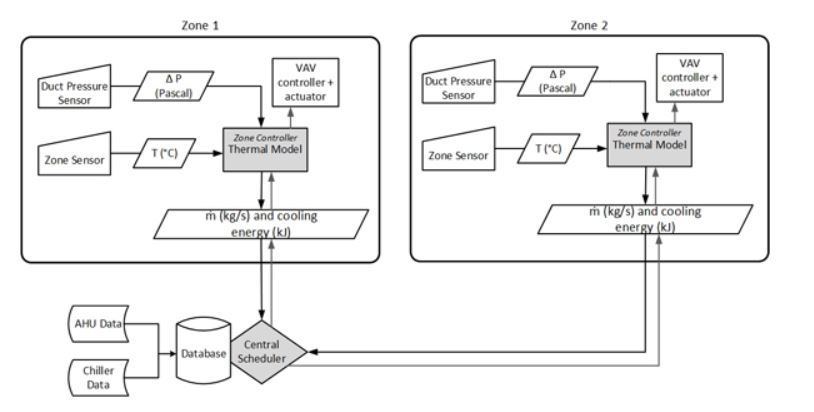Token-based Scheduling
Our interest is in minimizing the overall operational power consumption (fan power and chiller power) in the AC system through smart scheduling and distributed control. We propose a novel distributed architecture (called the token-based architecture) for controlling HVAC systems in commercial buildings.
 |
The zone module receives temperature, humidity, and carbon dioxide measurements transmitted from general room sensors. Then it performs forecasting of temperature, cooling load, and occupancy. This information is used to compute request for cooling in the form of mass flow rate. We called this a token request. The mass flow rate token request translates into damper opening (in the form of percentage) to be mechanically executed by the damper actuator. The entry of supply air into the zone (or room) is therefore adjusted.
The token requests from various zones may be competing with each other and eventually overloading the system, leading to energy inefficiency. Hence, a centralized scheduler is proposed to balance requests by allocating tokens to each zone efficiently by demand. In this approach, we minimize total energy use while respecting operational constraints.
In this model predictive control framework, zone modules update their local models based on the measured thermal response under allocated tokens. Then they re-compute and forward fresh token requests for subsequent time slots.
Our objective is to minimize the total energy consumption over the window k = 1,…,W, where
 |
is subject to zone thermal dynamics, constraints on the acceptable temperature ranges, and limits on the cooling air mass flow rates. Hp is hour; Pf is fan power; Pc is chiller power.
This proposed token-based architecture offers several advantages:
(a) The architecture is scalable in actual building implementation and robust to environmental changes.
(b) Computational burden on both the zone modules and the centralized scheduler is modest.
(c) The zone module only processes and handles its own zone, thus cutting down computation time.
(d) The hardware infrastructure will be modular. This implies that deployment cost will be reduced.